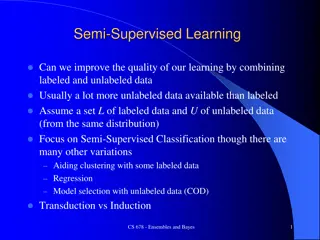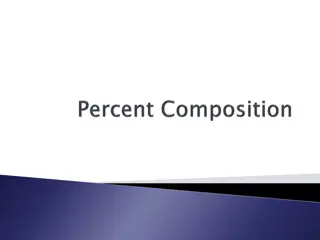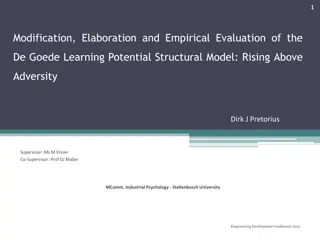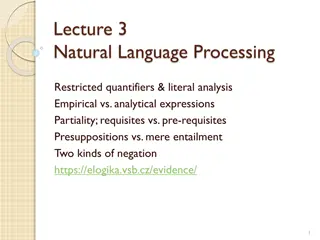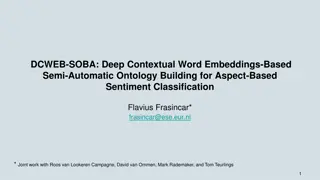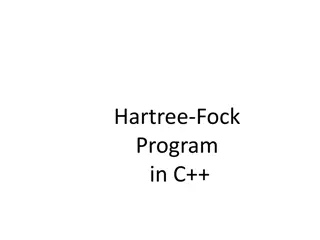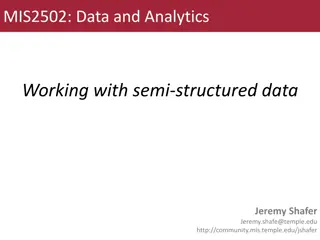Overview of Semi-Empirical Methods Based on Hartree-Fock
Semi-empirical methods derived from Hartree-Fock theory aim to reduce computational effort by approximating or eliminating electron repulsion integrals. Strategies include introducing adjustable parameters to replace ERI calculations and utilizing zero differential overlap methods like CNDO, INDO, NDDO, and PM3. These methods offer faster computations and lower memory requirements, albeit with reduced accuracy compared to traditional approaches. The Independent Particle Methods such as Hartree-Fock and Huckel Theory further simplify calculations by focusing on electron interactions within molecules.
Download Presentation

Please find below an Image/Link to download the presentation.
The content on the website is provided AS IS for your information and personal use only. It may not be sold, licensed, or shared on other websites without obtaining consent from the author.If you encounter any issues during the download, it is possible that the publisher has removed the file from their server.
You are allowed to download the files provided on this website for personal or commercial use, subject to the condition that they are used lawfully. All files are the property of their respective owners.
The content on the website is provided AS IS for your information and personal use only. It may not be sold, licensed, or shared on other websites without obtaining consent from the author.
E N D
Presentation Transcript
Semi Semi- -Empirical Methods Empirical Methods Based on Hartree-Fock as starting point Introduce approximations to decrease computational effort Eliminate/simplify most or all electron repulsion integrals (ERI) ( )= ( ) ( ) r12] ( ) ( )dV1dV2 n4 of these: n = # basis functions n=1000=103: # ERI~1012 Calculating ERI & entering them into the Fock matrix is main HF bottleneck Introduce adjustable parameters to replace ERI From experimental data or fitted to experimental data Advantages: Much faster, much smaller memory requirement Disadvantages: Lower accuracy; depends on how parameters chosen
Semi Semi- -Empirical Methods Empirical Methods Hierarchy of methods Eliminate ALL ERIs: Huckel theory: electrons only; focused on conjugated/aromatic molecules Extended Huckel theory (EHT): all valence electrons; similar to tight binding (TB) Very fast Zero differential overlap (ZDO) methods ( ) ( ) ( ) ( ) =Kroneker delta = 1 if = = otherwise So, for example, ERI ( ) ( ) # ERIs reduced from ~n4 to ~n2: easily stored in memory Not necessarily explicitly calculated
Semi Semi- -Empirical Methods Empirical Methods Zero differential overlap (ZDO) methods CNDO: Complete neglect of differential overlap (Pople) INDO: Intermediate neglect of differential overlap (Pople) NDDO: Neglect of diatomic differential overlap (Pople) Never really pursued by Pople MINDO: Modified INDO (Dewar) Differs from INDO in method of parameterization Pople: Primarily fit to reproduce Hartree-Fock Dewar: Fit to reproduce chosen experimental data: bond distances, 298K heats of formation MNDO/AM1: Modified NDDO (Dewar) PM3, PM6, PM7: Follow-on to AM1; many more fitted parameters (Stewart) Replaced all experimental data by fitted parameters AM1, PM3, NDDO are in GAMESS $BASIS GBASIS=AM1 [or PM3 or NDDO]
Independent Particle Methods Independent Particle Methods Hartree-Fock: FC=SC F=h+G h=one-electron terms (kinetic energy + electron-nuclear attraction) G=electron repulsion integrals Set G=0 F does not depend on orbitals. No iterations E= 2 Excitation from i a: E= a- i. cf HF: 1,3 E= a- i-Jia+Kia Kia Independent particle method cannot distinguish singlets & triplets Simplest: Huckel Theory electrons only: 1 electron/atom in hydrocarbons ZDO: FC=C hC= C h = = Coulomb integral=hAA;h = = resonance integral=hAB<0 Only between nearest neighbors Origin of chemical bonding
Independent Particle Methods: Independent Particle Methods: Benzene Benzene Analytic solution (circulant): No computer needed i= + cos(2 i/n ): i=0, 1, 2, n /2 n = electrons= # carbon atoms ( ) ( ) + ( ) + ( ) Benzene has 6 electrons: first 3 orbitals filled: 4n+2 rule Cyclobutadiene has 4 electrons: Ground state triplet. Singlet distorts to rectangular shape Huckel theory is very useful for qualitative understanding of conjugated hydrocarbons More complex molecules (e.g., naphthalene) require matrix diagonalization: computer
Independent Particle Methods: Independent Particle Methods: Extended Huckel Theory: All valence electrons hC=SC S not neglected h =valence shell ionization potential (VSIP h = K (h + h )S K=.75 EHT provides qualitative understanding, not quantitative
Methods that Retain Electron Methods that Retain Electron Repulsions Repulsions Most are zero differential overlap (ZDO) approximations Overlap matrix S=identity matrix I S = = unless = HF equations become FC=C Mulliken populations are simplified: no overlap population q =electron population in orbital =P =diagonal element of charge density/bondorder matrix qA=electron population on atom A = q = sum of electron populations in orbitals on atom A Pariser-Parr-Pople (PPP) electron method Became very popular in the 1960s when computers became broadly available Includes only electrons: 1 AO basis function/atom Repulsions depend only on atom centers, not on specific orbitals = AA = AB: on different atoms
Pariser-Parr-Pople (PPP) electron method Became very popular in the 1960s when computers became broadly available Includes only electrons: 1 AO basis function/atom Repulsions depend only on atom centers, not on specific orbitals = AA = AB: on different atoms h = U = = A: Similar to Coulomb integral in Huckel theory Taken from experimental VSIP h = = AB =0 except for bonded atom pairs: Similar to resonance integral in Huckel theory Source of covalent bonding Fitted parameter chosen to reproduce excitation energy in ethylene or benzene Inclusion of electron repulsions requires iterative solution like Hartree-Fock
CNDO: Complete neglect of differential overlap All valence electrons h =U = ( + ) (ZA-1/2) AA I=first ionization potential from experiment A=electron affinity from experiment Z=atomic number AA=electron repulsion integral on atom A h = = ABS =0 except for bonded atom pairs: Similar to resonance integral in Huckel theory Source of covalent bonding AB = [ + B]/2 fitted to reproduce HF orbital energy differences ( ) ( ) for all valence electrons
INDO: Intermediate neglect of differential overlap Very similar to CNDO Modified to enable: Correct prediction of singlet-triplet splittings in molecules Correct spin densities in radical species like CH3 Retains one-center ( ) integrals Derived from atomic spectral data MINDO: Modified intermediate neglect of differential overlap Formally identical to INDO Different choices of parameters AB fitted to experimental data Twice as many parameters ZINDO: Zerner INDO (Mike Zerner) Formally identical to INDO Parameters chosen to predict electronic spectra Gerry Small & BODIPY CNDO/S, INDO/S [C. Sandorfy] Alternative approach for electronic spectroscopy
NDDO: Neglect of diatomic differential overlap Retains ( ) integralsfor on A, on B MNDO/AM1/PM3/PM6 All based on NDDO with increasing number of fitted parameters









